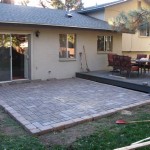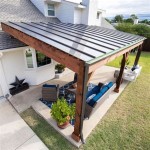Designing Your Dream Patio With Interlocking Deck and Tiles Design
Crafting an outdoor living space that seamlessly blends aesthetics, functionality, and durability requires careful consideration of design elements and material choices. Interlocking deck tiles and paving stones provide a versatile and increasingly popular solution for creating patios that are both beautiful and practical. The modular nature of these systems allows for easy installation, customization, and maintenance, making them an attractive option for both professional landscapers and DIY enthusiasts. This article will explore the key considerations involved in designing a dream patio using interlocking deck and tiles, covering aspects from planning and material selection to installation best practices and long-term maintenance.
The allure of interlocking deck and tile systems lies in their ability to transform ordinary outdoor spaces into inviting extensions of the home. Unlike traditional poured concrete or paver installations, interlocking systems do not require mortar or complicated sub-base preparation. This simplifies the installation process significantly, reducing both time and costs. Furthermore, the modular design enables easy repairs or replacements, ensuring the patio maintains its pristine appearance for years to come. The diverse range of materials, colors, and patterns available further enhances the design possibilities, allowing for a truly personalized outdoor living experience.
Planning and Preparation: Laying the Foundation for Success
Before embarking on the physical installation process, meticulous planning and preparation are crucial. This initial phase sets the stage for a successful and aesthetically pleasing outcome. The first step involves assessing the existing site conditions, including soil type, drainage, and any existing structures that might interfere with the patio design. A thorough evaluation will help determine the necessary site preparation and any potential challenges that need to be addressed proactively.
Next, defining the desired patio dimensions and layout is paramount. Consider the intended use of the space, the number of people it will accommodate, and the overall aesthetic you wish to achieve. Sketching a detailed plan, either on paper or using design software, is helpful in visualizing the final result and ensuring that the patio complements the surrounding landscape and architectural style of the house. Accurately measuring the area and marking the boundaries will provide a clear guide during the installation process.
Proper drainage is essential for the longevity of any patio. Evaluate the existing drainage patterns and identify any areas where water accumulates. Implementing drainage solutions, such as grading the area to direct water away from the house or installing a drainage system, is critical to prevent water damage and ensure the patio remains structurally sound. The selection of suitable base materials is also crucial for providing a stable and level foundation for the interlocking deck and tiles. Crushed gravel or compacted sand are typically used as base materials, and the depth and compaction of the base should be determined based on the soil type and anticipated load.
Finally, carefully consider the access points and integration with existing landscaping features. Ensure that the patio seamlessly connects to walkways, driveways, and other outdoor spaces. Integrating plants, shrubs, and trees into the patio design can enhance its aesthetic appeal and create a more inviting atmosphere. Careful planning at this stage will ensure that the finished patio is not only visually stunning but also functional and seamlessly integrated into the surrounding environment.
Choosing the Right Materials: Balancing Aesthetics and Functionality
The selection of appropriate materials is a critical decision that significantly impacts the overall look, durability, and longevity of the patio. Interlocking deck and tile systems are available in a wide range of materials, each offering unique characteristics and advantages. The most common materials include wood, composite, stone, and concrete, each with its own distinct aesthetic appeal and performance properties. The choice of material should be guided by factors such as budget, desired aesthetic, climate conditions, and maintenance requirements.
Wood deck tiles offer a natural and warm aesthetic, creating a comfortable and inviting outdoor space. Popular wood choices include cedar, redwood, and teak, all known for their durability and resistance to rot and decay. However, wood requires regular maintenance, such as staining or sealing, to protect it from the elements and prevent warping, cracking, and fading. Composite deck tiles, on the other hand, are made from a blend of wood fibers and plastic, offering a low-maintenance alternative to natural wood. Composite materials are resistant to fading, staining, and insect damage, making them an ideal choice for areas with harsh weather conditions. They can mimic the look of natural wood while requiring minimal upkeep.
Stone and concrete interlocking tiles provide a more formal and durable option. Stone tiles, such as slate, travertine, and bluestone, offer a timeless and elegant look. They are incredibly durable and resistant to weathering, making them ideal for high-traffic areas. However, stone tiles can be more expensive than other options and require careful installation to ensure a level surface. Concrete interlocking pavers are a versatile and cost-effective choice, available in a wide range of colors, shapes, and textures. They are durable, easy to install, and require minimal maintenance. Concrete pavers can be designed to mimic the look of natural stone, providing a more affordable alternative.
In addition to the primary material, consider the interlocking system itself. Opt for high-quality systems that are designed for durability and ease of installation. Look for interlocking mechanisms that are robust and provide a secure connection between the tiles or pavers. The interlocking system should also allow for proper drainage and expansion to accommodate temperature fluctuations. Ultimately, the choice of materials should reflect a balance between aesthetic preferences, budget constraints, and performance requirements, ensuring the patio is both beautiful and functional for years to come.
Installation Techniques and Best Practices: Ensuring a Flawless Finish
Proper installation is crucial for ensuring the longevity and aesthetic appeal of the patio. While interlocking systems are generally easier to install than traditional paving methods, adhering to best practices and following manufacturer instructions is essential for a flawless finish. The installation process typically involves preparing the base, laying the tiles or pavers, and securing the interlocking mechanisms.
Begin by ensuring that the base is properly prepared. The base should be level, compacted, and free of any debris. Use a level to check for any uneven areas and adjust the base material as needed. Compact the base material using a plate compactor to create a stable and firm foundation. The depth of the base material will depend on the soil type and anticipated load, but generally, a minimum of 4-6 inches of compacted gravel or sand is recommended.
Next, lay the interlocking tiles or pavers according to the chosen pattern or design. Begin at a corner or edge and work your way across the patio area. Ensure that each tile or paver is properly aligned and interconnected with the adjacent ones. Use a rubber mallet to gently tap the tiles or pavers into place and ensure a tight and secure fit. Periodically check the level of the patio using a level and adjust the base material as needed to maintain a consistent and even surface. When cutting tiles or pavers to fit around edges or corners, use a saw or cutting tool specifically designed for the material. Ensure that the cuts are clean and precise for a professional finish.
Once all the tiles or pavers are laid, secure the interlocking mechanisms. Depending on the type of system, this may involve snapping the tiles together, clipping them in place, or using screws or fasteners. Follow the manufacturer's instructions carefully to ensure that the interlocking mechanisms are properly engaged and provide a secure connection between the tiles. After securing the interlocking mechanisms, fill any gaps or joints with sand or gravel to provide additional stability and prevent weeds from growing between the tiles. Sweep the patio clean and remove any excess sand or gravel.
Finally, inspect the finished patio for any imperfections or uneven areas. Make any necessary adjustments to ensure that the patio is level, stable, and aesthetically pleasing. Proper installation will not only enhance the beauty of the patio but also ensure its longevity and resistance to weathering. Regularly inspecting the patio and addressing any issues promptly will help maintain its pristine appearance for years to come.
In summary, designing a dream patio with interlocking deck and tiles involves careful planning, material selection, and installation techniques. By considering the site conditions, defining the desired layout, choosing the right materials, and adhering to best installation practices, one can create an outdoor living space that is both beautiful and functional, transforming an ordinary backyard into an inviting extension of the home.

Paver Patio Ideas Design Tips For Patios Unilock
5 Patio Designs That Wow Unilock

9 Patio Ideas Create The Ultimate Outdoor Space

Gogexx 12 In X Square Acacia Wood Interlocking Flooring Deck Tiles Stripe Pattern Patio Brown Pack Of 20

Patio Perfection A Step By Guide To Designing And Building Paver

10 Best Patio Floor Tiles Plus Top 15 Designer Approved Ideas George Buildings
45 Modern Deck And Patio Ideas Designs Renoguide N Renovation Inspiration

Gogexx 12 In X12 Square Acacia Wood Interlocking Flooring Deck Tiles Stripe Pattern For Patio Brown Pack Of 20

Achim Outdoorz Interlocking Wood Deck Tiles Honey Oak 27 Sq Ft

2025 Outdoor Flooring Trends 10 Ways To Upgrade Your Space
Related Posts








